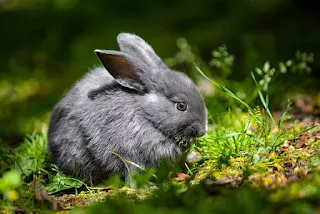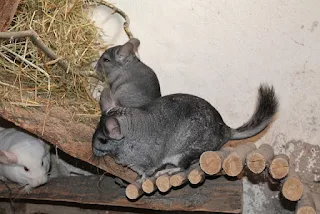Exploring the Enigmatic Chinchilla: A Guide to These Fascinating Furballs
Introduction:
Welcome to the wonderful world of chinchillas! These fluffy creatures are renowned for their soft fur, playful antics, and charming personalities.
This comprehensive guide delves into the captivating world of chinchillas, exploring their habits, habitat, care requirements, and much more.
Let's embark on a journey to discover the mysteries of the Chinchilla!
The Origins of the Chinchilla:
 |
| Aerial view of the Andes mountain range where chinchillas originate. |
Chinchillas are fascinating rodents indigenous to the Andes Mountains in South America. They thrive in the rocky, arid terrains of high altitudes, where they have adapted to the harsh living conditions over the years.
These cute creatures are known for their soft, dense fur, which helps them stay warm in the cold mountain climate.
Chinchillas are social animals and often live in groups, making them a delightful sight in their natural habitat.
These agile rodents have adapted to their harsh environment, developing thick, luxurious fur to keep them warm in the cold Andean nights.
The name "chinchilla" derives from the indigenous Quechua language, meaning "little Chincha," a reference to the people who once inhabited the region.
Chinchilla populations were significantly reduced due to hunting for their fur, leading to their classification as endangered species.
However, conservation efforts and breeding programs have helped stabilize their numbers in the wild and increase their presence in captivity.
Chinchillas are cherished pets worldwide and are admired for their beauty and charm.
Chinchilla Care and Maintenance:
Proper care is essential for keeping chinchillas healthy and happy. These creatures thrive in spacious cages with plenty of room to climb and explore.
A dust bath is vital to their grooming routine, as it helps them maintain their silky fur and removes excess oils.
Additionally, chinchillas require a diet rich in hay, supplemented with pellets and fresh vegetables, to ensure they receive all the necessary nutrients.
Regular veterinary check-ups are crucial for monitoring their health and promptly addressing potential issues.
Chinchillas are susceptible to dental problems, so they must offer chew toys and ensure they can access hay to maintain their dental health and prevent overgrowth.
Chinchilla Behavior and Socialization:
Chinchillas are highly social animals that thrive in the company of their own kind. In the wild, they live in colonies, engaging in grooming rituals and playful interactions with their fellow chinchillas.
When kept as pets, chinchillas benefit from companionship, so it's advisable to house them in pairs or small groups whenever possible.
These curious creatures are also incredibly active. They spend much of their time exploring their environment and engaging in playful behaviors like jumping and climbing.
Providing plenty of toys and opportunities for exercise is essential for keeping them mentally stimulated and preventing boredom.
Housing and Environmental Needs:
Creating a suitable habitat for chinchillas is essential for their health and well-being. Large, multi-level cages with plenty of space for exercise and exploration are ideal.
Maintaining proper temperature and humidity levels is also crucial, as chinchillas are sensitive to heat and humidity.
Common Health Issues and Concerns:
While chinchillas are generally hardy animals, they are susceptible to specific health issues that owners should know.
Respiratory infections, dental problems, and gastrointestinal issues are among the most common ailments seen in pet chinchillas.
Symptoms such as lethargy, loss of appetite, and difficulty breathing should never be ignored, as they could indicate a severe underlying problem.
Prompt veterinary attention is crucial for effectively diagnosing and treating health issues, so it's essential to have a trusted exotic animal veterinarian on hand.
Conclusion:
Chinchillas are fascinating creatures with a long and storied history. These adorable little animals are known for their incredibly soft and fluffy fur, which is highly prized in the fashion industry.
However, chinchillas are much more than just a source of luxurious fur. They are intelligent, curious, and playful, with unique traits and behaviors that make them truly fascinating to observe and interact with.
While chinchillas can be kept as pets, they require a specialized diet and living environment to thrive.
Despite their specific care requirements, chinchillas make excellent pets for those willing to provide them with the proper care and attention.
They are social animals that enjoy interacting with their owners and playing with toys, and they have a unique personality that can be pretty endearing.
Whether as pets or admired from afar, chinchillas are truly remarkable creatures that never fail to delight and enchant.
By providing them with the care, love, and attention they need, we can help ensure that these fluffy furballs continue to thrive for generations to come.
Additional Resources
For further information on chinchilla care, recommended resources include books such as "The Chinchilla Handbook" by Sharon Lynn Vanderlip and websites like the Chinchilla Care Guide. Additionally, joining online forums and communities dedicated to chinchilla owners can provide valuable support and advice.
Frequently Asked Questions:
Q: Are chinchillas good pets for children?
A: While chinchillas can make excellent pets, they require gentle handling and responsible care. Young children should always be supervised when interacting with chinchillas to prevent accidents and ensure the animals' well-being.
Q: How long do chinchillas live?
A: Chinchillas have relatively long lifespans, typically living between 10 to 15 years when cared for properly. Providing a healthy diet, regular veterinary care, and a stimulating environment can help maximize their lifespan.
Q: Can chinchillas be litter-trained?
A: Yes, chinchillas can be trained to use a litter box, although it may require patience and consistency. Placing the litter box in a corner of their cage where they tend to eliminate can encourage them to use it regularly.
Q: Do chinchillas need regular grooming?
A: Chinchillas are fastidious groomers and typically do not require regular baths. However, they do need access to a dust bath to keep their fur clean and healthy. Dust baths should be provided a few times a week to allow them to groom themselves effectively.



Comments
Post a Comment